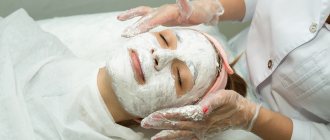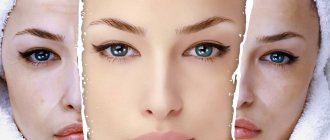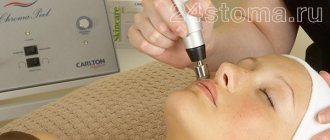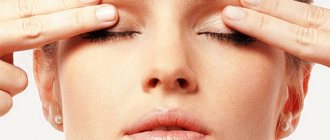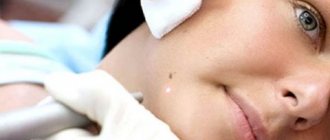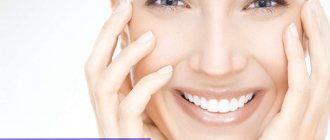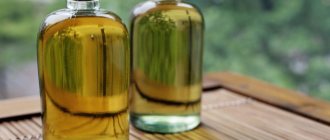To avoid side effects after peeling, you must take care of your face in accordance with the recommendations of a cosmetologist.
The procedure is always associated with a violation of the structure of the skin, and during the recovery period it is permissible to use only medicinal and cosmetic products approved by a specialist. If you ignore skin care after peeling, the likelihood of complications increases, which will take a long time to correct.
How does peeling affect facial skin?
There are many types of exfoliation, but the principle is the same - disruption of epithelial tissue and stimulation of regenerative processes in the epidermis and dermis. This is how the physiological process of rejuvenation occurs. Our body is designed in such a way that it perceives injury after chemical peeling as an impulse to start the regeneration process. As a result, active formation of collagen fibers and hyaluronic acid molecules occurs. The epidermis is freed from dead cells of epithelial tissue, acquiring youth and elasticity.
Every woman should have a clear idea of what happens in her facial skin after peeling. The renewed epithelium forms new cells and tissues, and therefore requires special care. Even minor exposure to external factors can be dangerous for unformed epidermis. Therefore, any exogenous influence should either be excluded or minimized. Even your usual walks in the fresh air and familiar facial care products can worsen the condition of your skin after facial peeling, causing side effects. Therefore, cosmetologists and women with extensive experience in exfoliation recommend scheduling it at the end of the work week. Over the weekend, the skin will recover and by the beginning of next week the first positive results of exfoliation will be visible. Taking precautions, you need to follow the recommendations of specialists and after peeling, apply a cream that promotes rapid healing of the epidermis.
Even if you have undergone superficial facial exfoliation, which is gentle, you need to be careful. Dry and sensitive skin after exfoliation is especially susceptible to various environmental factors. If the cosmetologist did not focus your attention on post-peeling care, you should follow the general recommendations. You can learn in detail about how to care for your facial skin after peeling from our article.
What problems does peeling with fruit acids solve?
- excessive oily skin,
- increased secretion of sebaceous glands,
- acne, comedones,
- traces of acne (including hormonal),
- wide pores,
- dull complexion,
- small wrinkles,
- low skin tone,
- low skin elasticity, inelasticity,
- skin roughness, unevenness, large stratum corneum.
Since fruit peeling acts superficially, it perfectly cleanses the skin, helps get rid of small wrinkles, the face acquires a healthy color, and excess pigmentation disappears.
But you shouldn’t expect that deep wrinkles will disappear after exposure to fruit acids. To combat them, you need to use other, more serious means. https://youtu.be/https://www.youtube.com/watch?v=uZjCy7Cr96Q
How to restore skin after peeling?
There are a number of recommendations on how to restore skin after peeling. Their spectrum depends directly on the type and depth of exfoliation performed. The individual characteristics of the patient are also taken into account: skin type, age, tendency to allergic reactions, presence of chronic diseases.
If we consider the types of complications and side effects after exfoliation, we can name the following phenomena:
- Peeling is a normal consequence of the procedure. The feeling of dryness and tightness on the 3rd day transforms into detachment of epidermal particles, which spontaneously disappears after a maximum of a week. Natural products based on shea butter, jojoba, grape seed and with the addition of hyaluronic acid will help speed up the process;
- Hyperemia or redness is characteristic of rehabilitation after deep or median exfoliation. This side effect will go away in 5-20 days. The main thing during this period is to maintain a gentle diet, moderate physical activity and avoid stress. It is recommended to include foods rich in omega-3 acids in your diet;
- Swelling after exfoliation occurs in those with thin skin. On the recommendation of a cosmetologist, you can use a special facial gel after peeling with antioxidants that eliminates swelling;
- Inflammatory elements can result from incorrect exfoliation or improper post-peeling care. There are a number of spot-on products with antiseptic ingredients that will help in this case;
- An allergy may occur if an allergy test was not performed before the exfoliation procedure. If this reaction occurs, an antihistamine should be used;
- Increased pigment formation can be caused by improper preparation for exfoliation or exposure of the skin to sunlight after the procedure. Whitening creams and a diet that excludes foods that increase pigmentation will help cope with freckles or brown spots.
Each type of exfoliation has its own rehabilitation period. How to restore the skin after each of them?
Superficial
As you know, skin care after superficial peeling is the least troublesome. In this case, only the upper part of the epidermis is exfoliated. Just a couple of days after peeling, a film of young epidermal cells is formed. They require gentle care. After a superficial chemical peel, you should not use scrubs or roll off flaky and reddened epithelium for at least a week. Typically, a cosmetologist recommends using a cream that accelerates wound healing. After superficial peeling, skin care with panthenol-based ointments and creams is appropriate. This substance activates regeneration and prevents scar formation. It would be a good idea to drink an extra liter of water, which speeds up metabolic processes in the body.
Skin care after peeling with fruit acids and other types of gentle exfoliation involves the use of products that are gentle and contain a high sun protection factor. Apply them every time you go outside. When caring for your skin after peeling with acidic compounds, do not use alkaline, aggressive hygiene products that cause irritation to the epidermis.
Middle
Median exfoliation is a more serious effect on the skin with coral, trichloroacetic acids or a multi-acid composition. Therefore, after a mid-type chemical peel, a longer rehabilitation period follows. In this case, a woman may experience redness and peeling of the skin.
Many women are interested in the question: is it possible to cleanse the skin after peeling? The answer is clear: no! Do not use scrubs, roll or peel off scales with your hands. This leads to the formation of scars, which will be very difficult to remove! It is enough to wait a few days after the mid-peel without special care, and the peeling will go away on its own.
Skin care after chemical exposure should be very delicate. It is necessary to avoid both mechanical and chemical effects on the injured epidermis. As a facial cleanser, 3 days after peeling, you can wipe only with micellar water or another mild product without sulfates in the composition. You should also not use cosmetics, as you will need to remove makeup. Subsequent skin care after medium peeling is limited to the use of wound healing agents and the use of sunscreens.
Glubokoye
Deep exfoliation is a serious cosmetic and medical procedure and is performed under anesthesia. Phenolic, brown facial peeling, as well as laser resurfacing are effective methods for eliminating significant defects in the epidermis. But it should be understood that these types of exposure are highly traumatic.
Aftercare for this type of chemical peel can be done in a hospital setting, as the patient receives a controlled burn to the deep layers of the skin. Rehabilitation requires sterility and the use of medications: anabolic steroids, antibiotics and other drugs. This helps to cope with pain and prevents infection of the damaged dermis.
Care after the deep peeling procedure is special. For the first few days, you should not wash your face with water. After this, do not wipe your face with alcohol-based lotions. After deep peeling, part of skin care is the use of creams with a high UV protection factor. This mandatory requirement will help avoid the appearance of unwanted pigment spots.
Remember: washing your face during the rehabilitation process can be done with boiled warm water. The face should not be wiped, but blotted with a towel. Skin care after deep peeling can be carried out with products in the form of gel or foam. They do not need to be rubbed into the skin; they are easily absorbed.
Skin care after laser peeling and other deep effects is prescribed by a cosmetologist individually. Remedies for restoring serious damage to the epidermis usually include antioxidant substances: ubiquinone, tocopherol, selenium and other bioflavonoids.
Attention! The use of homemade masks during the rehabilitation stage must be agreed upon with a cosmetologist. Many components can trigger allergies, as skin sensitivity is increased.
What effect to expect
Regardless of skin type, the effect of peeling is positive: after this procedure, it is cleansed, strengthened, tightened and rejuvenated.
But still, fruit acids do not act the same on different skin types:
- Dry skin . When fruit acids are applied, skin irritation occurs, metabolic processes and the influx of beneficial substances are increased: moisturizing, nourishing, and stimulating recovery processes. As a result of the procedure, the skin literally “comes to life”, its color improves, it smoothes out and acquires a healthy pink tint.
- Oily skin . For this type of skin, fruit acids act as “cleaners”: fat, dirt, and cosmetic residues are removed from the mouths of the sebaceous and sweat glands.
If you do this procedure regularly, the hydro-lipid balance of the skin returns to normal, and the use of caring cosmetics becomes as effective as possible.
General recommendations from cosmetologists
Typically, skin care after chemical peeling is discussed individually by a cosmetologist. It consists of many factors. The depth of exposure, the characteristics of the skin and the health of the patient are taken into account. However, there are general recommendations after facial peeling that can be called universal.
During the day after exfoliation, you cannot:
- Wash your face with soap, foam or gel;
- Touch, massage, rub, scratch the skin;
- Use moisturizing creams, nourishing serums, mattifying masks or lotions;
- Stay outside for a long time and come into contact with the sun's rays;
- Swim in the pool, take a steam bath, engage in active sports;
- Visit the solarium.
The next three days after exfoliation it is recommended:
- Wash your face with water with a slightly acidic pH or using a hypoallergenic, lightweight cleanser;
- Apply cream after peeling for the face with a wound healing effect. They usually contain panthenol or lanolin;
- Limit going outside, especially in sunny weather;
- Use products with a UV filter (SPF index - at least 35);
- Protect the skin from negative external factors: frost, wind, dust, sun.
For two weeks after exfoliation, you should adhere to the following recommendations:
- Use medications and creams prescribed by a cosmetologist;
- Refrain from using decorative cosmetics that clog pores;
- Do not remove scales, crusts, or scabs with your hands;
- Do not use scrubs, even the most delicate ones;
- Do not sunbathe in a solarium or in the sun, use sunscreen;
- Do not experiment with new brands of care cosmetics;
- Do not visit public baths, swimming pools, or open water bodies.
You've probably heard a lot of advice from friends and acquaintances on how to care for your face after chemical peeling, but you should only follow the recommendations of experienced cosmetologists. They will protect you from negative consequences in the form of complications and side effects.
Operating principle
Glycolic acid has other traditional names - hydroxyacetic acid and hydroxyethanoic acid. It belongs to the class of alpha hydroxy acids (AHAs), which are used for superficial and medium exfoliation (very rarely).
Glycolic peeling is suitable for all skin types. The main thing is to prepare for it correctly, to choose the appropriate concentration of hydroxyethanoic acid.
Before the course of exfoliation, you need to prepare the epidermis for two weeks, loosening it with nightly use products with a concentration of the main active ingredient of 3-5%.
Then the main procedure is carried out in the salon or at home with an initial concentration of up to 20%, repeating it every ten days 6-8 times.
After two months, the glycolic peel is repeated with a higher concentration to achieve results.
The advantages of such exfoliation:
- suitable for all types;
- effectively rejuvenates at the cellular level, activating the formation of collagen fibers, prevents aging;
- stimulates breathing and metabolic processes of the skin, enriching it with oxygen;
- evens out the relief, tightening pores and removing unevenness;
- polishes the skin after plastic surgery;
- eliminates age spots, whitens;
- inhibits the activity of bacteria that cause acne.
A relative disadvantage of the procedure is its gradual nature. Glycolic peeling does not give you great results right away.
The impatient, deceived by the gentleness of the effect, risk getting light chemical burns on the unprepared epidermis.
But by showing patience and endurance, you can make your face look young, rested, with an even texture and beautiful color.
How to deal with complications?
Unfortunately, exfoliation can bring not only smooth, glowing skin, but also scarring, acne, hyperpigmentation, and worsened cold sores.
Pigmentation is a rather unpleasant side effect of laser exfoliation and TCA. To prevent this, treat your face with kojic and retinoic acids before exfoliation. Some post-peeling treatments also remove subsequent pigmentation. This is the application of acetylcysteine and strong antioxidants (tocopherol, ascorbic acid, silene, etc.) to the epidermis.
Exacerbation of herpes may occur in those individuals who note this phenomenon at least twice a year. To prevent foci of herpes from spreading across the face after scrubbing or peeling the face, it is necessary to carry out appropriate therapy: take antiviral medications: oral medications and ointments.
If a woman is prone to acne, after exfoliation it may appear in an aggravated form. Agents with anti-inflammatory and sebostatic properties will be required. Antiseptic preparations with zinc can be applied pointwise to pimples and blackheads.
Severe peeling of the skin can also be observed after medium or deep exfoliation. There is no need to take any measures, the skin should exfoliate on its own. How to exfoliate skin faster after peeling? Cosmetologists strongly recommend: do not comb, do not pick off scales and do not use scrubs. All these manipulations can lead to scar formation.
Carrying out the procedure yourself at home
How to do a glycolic peel at home? This becomes interesting for women who want to save on going to a beauty salon. For the procedure, you need to buy a kit designed for such manipulations. This can be done at a pharmacy or specialty store. Before you directly begin peeling your face at home, you need to do a test for allergic reactions, which can sometimes occur to the components contained in glycolic acid.
If severe discomfort, redness, swelling or other negative reactions occur, quickly wash off the composition from the skin. In this case, glycolic peeling on the face is prohibited. If there are no reactions to the substance, it is allowed to use this method of cleansing the epidermis.
How to properly prepare and do
Then you can proceed directly to the procedure itself. The first manipulations should be carried out with a weak concentration of glycolic acid, gradually increasing its amount, doing this session by session. To apply a product that contains glycolic acid to your face, you need to take a cotton pad or a flat brush. When performing these manipulations, it is recommended to adhere to some sequence. First, the drug is applied to the forehead, then to the nose, cheeks, and only finally to the chin.
It is very important that the acid does not get on the epidermis around the eyes and lips; for them you need to do a separate peeling for the lips. The duration of the procedure is 2-5 minutes, but if burning or redness occurs, you must immediately wash off the composition
To remove the mass from the skin, a special neutralizing agent is used, which has a slightly alkaline pH level. This substance also comes complete with glycolic acid for peeling. The neutralizer must be applied with a cotton pad, carefully wiping the skin. After this, cosmetologists recommend washing your face with cold water, a decoction of chamomile, calendula or green tea.
To achieve the desired effect, you will need to conduct 5-10 sessions, with a break between them of at least 14 days. But experts recommend an interval of 4 weeks. In between procedures, you can apply creams containing glycolic acid. This will improve and consolidate the results obtained. You can learn about retinoic peeling at home here.
In the video - glycolic peeling yourself:
Since this substance is found in large quantities in grapes, cleansing at home is often performed using peelings based on this berry. This saves a lot of money, because cosmetics are quite expensive. To cleanse your face you need to take 1 tbsp. l. regular washing gel or milk, mix with 1 tsp. grape oil and the same amount of ground fruit seeds. To enhance the effect, add a little juice from these berries. The resulting product is applied to the epidermis with massage movements, kept for 4-5 minutes and washed off with cold water.
You can also exfoliate your body at home with natural glycolic acid. You need to take 1 tbsp. l. shower gel, mix with the same amount of ground grape seeds. The prepared preparation must be used while bathing. It is applied with massaging movements and washed off immediately.
How to care for your facial skin after peeling at home?
The most important thing is to allow the epidermis to recover and not interfere with the natural regeneration process. After peeling, the skin of the face will begin to tighten, dryness will appear, and then peeling. These phenomena are natural and natural; there is no need to panic. Under no circumstances should you use a scrub after peeling your face. The injured epithelium will react to this action with scars and cicatrices, which are very difficult to remove.
The main thing in rehabilitation is gentle care. Can I wash my face after peeling? After deep and medium exposure, you should not wash your face with water on the first day. Over the next few days, you can only wash with boiled water. Then, for several weeks, it is recommended to use soft cleansers with a gentle hypoallergenic composition.
If a cosmetologist has prescribed medications (antibiotics, anabolic steroids, wound-healing ointments), they cannot be ignored. This can lead to irreparable consequences. The effect of exfoliation depends not only on the professionalism of the cosmetologist, but also on the responsibility of the woman herself.
What is not forbidden to do after peeling? Repeatedly in this article it was stated what is prohibited to do after peeling. This means injuring the epidermis, staying in the sun and using any cosmetics.
Important! Despite the standard set of warnings from a cosmetologist, women are often concerned about the question: is it possible to wet their face after peeling? After deep and medium exfoliation, do not wet your face for 24 hours. Then you can wash only with boiled warm water.
A woman should understand that after a chemical peel, the quality of the result obtained largely depends on her actions. It is necessary to strictly follow the recommendations and exclude amateur activities. Only a professional can adequately assess the need or danger of even the safest procedure in your opinion. For example, after chemical exfoliation, you should not massage your face or even touch it. The sensitivity of the damaged epidermis is high, it can be easily harmed.
The cosmetologist recommends how to care for the skin after peeling so that the epidermis is restored without scars and blemishes immediately after the procedure. In addition to a number of standard manipulations, the beauty salon master will share with you special secrets of maintaining the peeling effect and prescribe a suitable line of products for post-peeling care. But keep in mind that you can use cleansers after facial peeling only after 3-4 days.
The rehabilitation period, depending on the depth of exfoliation, can last up to 3 weeks. In this case, you need to use cosmetics with extreme caution. The main thing is to avoid irritation, allergies, and clogged pores. When the epidermis is completely restored, you will again be able to use your favorite decorative cosmetics.
When is it possible and when not to perform glycolic exfoliation?
Glycolic peeling is actively used in the fight against photoaging and small wrinkles. If a person has enlarged pores, acne, comedones, or is diagnosed with oily seborrhea, then the product can be used in complex therapy. Chemical peeling is performed in the presence of scars, spots, fresh stretch marks, as well as decreased skin tone, loss of natural color and hyperkeratosis. At the preparatory stage for laser resurfacing or plastic surgery, the skin is treated with glycolic acid.
Despite the wide range of indications and the relative painlessness of the procedure, it is contraindicated for:
- a tan that is less than half a month old;
- individual intolerance to ingredients;
- chronic dermatological diseases in the acute stage;
- oncological and acute infectious diseases;
- the presence of skin damage in the area intended for treatment;
- tendency to the appearance of vascular “stars” and keloid scars;
- pregnancy and breastfeeding.
VBG Cosmetic cosmetologists do not recommend glycolic peeling for dark-haired people with dark skin. Spring and summer are not the right time for deep cleaning. If you have recently undergone chemotherapy or hormonal treatment; or is undergoing a treatment course with glucocorticosteroids, glycolic exfoliation is contraindicated. In any case, you need to consult a cosmetologist.
Summary
Proper care after peeling guarantees a woman a good result from the procedure and protects her from complications. Adverse reactions arise not only through the fault of the cosmetologist, but also from how the rehabilitation period goes. It is necessary to strictly follow all the recommendations of the salon master, use all prescribed products and medications and avoid amateur activities. Then exfoliation will be very effective, and the risks of complications will be reduced to zero. Skin glowing with beauty and youth will be a reward for your patience.

